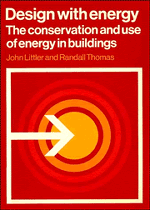Book contents
- Frontmatter
- Contents
- Units, symbols, abbreviations, conventions and conversion factors
- Preface
- 1 Energy and buildings
- 2 Site planning and analysis
- 3 Building design
- 4 Passive solar design
- 5 Active solar heating
- 6 Space heating and ventilation
- 7 Thermal storage
- 8 Wind energy
- 9 Water-supply systems
- 10 Waste disposal and utilization
- 11 Domestic-energy saving
- 12 Housing case studies
- 13 Non-domestic case studies
- Appendix 1 Weather data
- Appendix 2 Thermal performance
- Appendix 3 Interstitial condensation
- Index
10 - Waste disposal and utilization
Published online by Cambridge University Press: 03 February 2010
- Frontmatter
- Contents
- Units, symbols, abbreviations, conventions and conversion factors
- Preface
- 1 Energy and buildings
- 2 Site planning and analysis
- 3 Building design
- 4 Passive solar design
- 5 Active solar heating
- 6 Space heating and ventilation
- 7 Thermal storage
- 8 Wind energy
- 9 Water-supply systems
- 10 Waste disposal and utilization
- 11 Domestic-energy saving
- 12 Housing case studies
- 13 Non-domestic case studies
- Appendix 1 Weather data
- Appendix 2 Thermal performance
- Appendix 3 Interstitial condensation
- Index
Summary
Introduction
Surprisingly enough, several years ago one of the highlights in California Governor Jerry Brown's politics was the introduction of a law forbidding the sale of any lavatory which flushes more than 141 of water. Waste disposal does not often receive such publicity although the problems it entails in both industrialized and non-industrialized countries, albeit for different reasons in the two groups, are impressive.
Here we shall deal with wastes in greater detail than we did with water systems but not because the central network is less extensive – in the UK 94% of all households are connected to mains sewers (in the US, on the other hand, the comparable figure is about 67%). Rather, it is because wastes can be a source of on-site energy if methane digesters are used. Although this tends to be less practical at the level of a single home, groupings of houses and other building types such as schools should not ignore the energy potential of the wastes they produce.
Mains servicing in the UK, as elsewhere, consists of a cistern-flush toilet connected to a network of underground sewers which transport sewage and domestic waste water to a treatment or disposal facility. While to those of us who use such systems almost nothing seems more natural, it is of interest to note that the concept of using storm sewers for human wastes is only about 140 years old and the first integrated system only came into full use about 1870 in London. The first sewers merely conveyed the wastes to bodies of water where they were discharged with often disastrous consequences – sadly this practice continues today in many areas.
- Type
- Chapter
- Information
- Design with EnergyThe Conservation and Use of Energy in Buildings, pp. 293 - 303Publisher: Cambridge University PressPrint publication year: 1984



